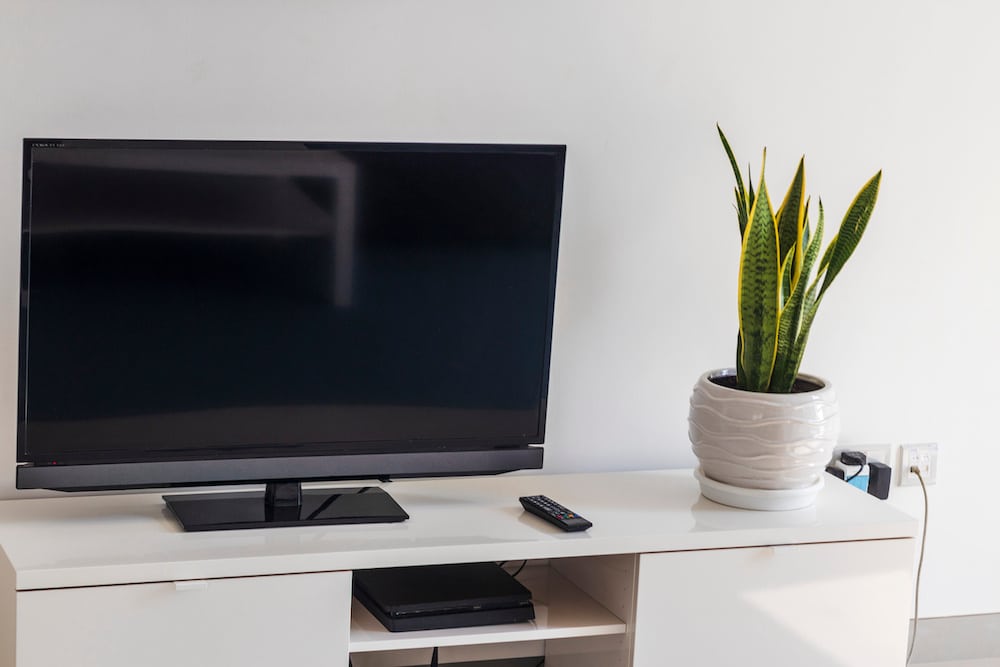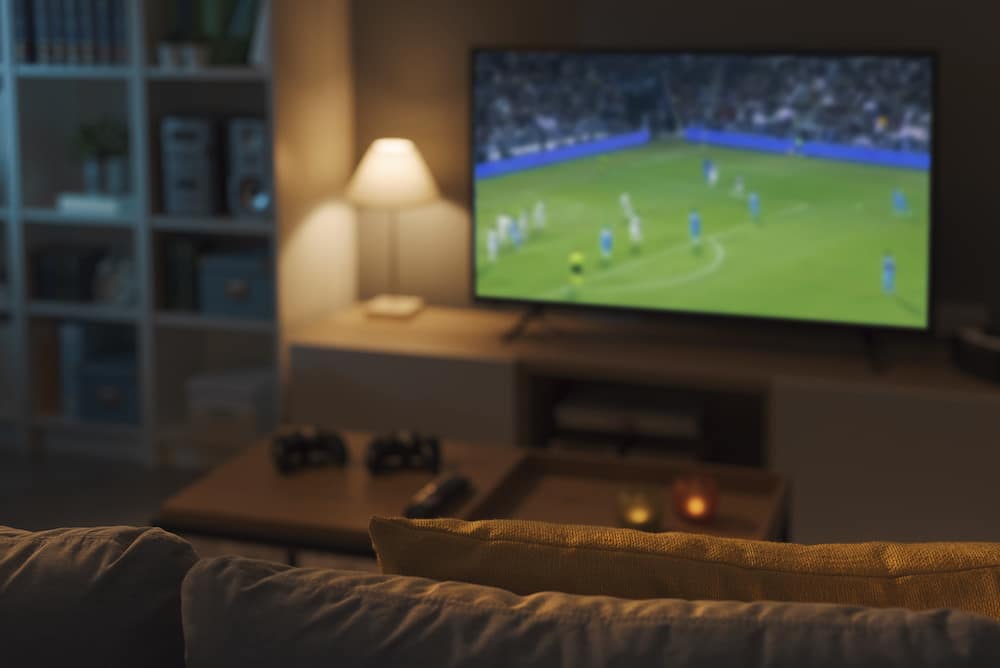the essentials in brief
Clouding can at LCD- Screens occur at all times, especially on older devices. However, it can also occur with new devices, especially if they have not been transported or stored properly. More details here...
To reduce the problem, one can lower the screen backlight or adjust the room lighting. Learn more about it here...
Whether clouding is a warranty case depends on the manufacturer's specific warranty conditions. More details here...
What is clouding? Clouding TV is a phenomenon that can occur with modern LCD televisions and is an annoying problem for many viewers. As LCD TVs become more popular and can be found in many homes, it is important to learn more about this problem and how to reduce or avoid it.
In this context, we will take a closer look at the phenomenon of clouding in TV sets. It will first answer the question - "What is clouding?" Then tips will be given on how to deal with it.
Contents
Clouding – A brief explanation

What is clouding? Clouding TV is a term used to describe the phenomenon of uneven distribution of brightness on an LCD TV to describe. It occurs when the TV backlight is not evenly distributed across the entire screen, causing clouding or a bright spots on the TV arise.
Did you know already?
LCD stands for "Liquid Crystal Display" and refers to the technology used in most flat screen televisions. LED stands for "Light Emitting Diode" and refers to the type of backlight used in many LCD televisions.
One can easily notice Clouding TV by looking at dark scenes on the screen considered. Typically, areas of the screen that should be dark are spoiled by bright spots or cloudiness. In some cases, the clouding effect even in bright scenes occur, especially when looking at the TV from different angles.
The clouding effect is on common problem with LCD TVs and can occur on different models and brands. However, it can also be affected by various factors such as the age of the TV, the room temperature and the type of backlight. In some cases, clouding can also be caused by improper handling of the TV during transport or installation.
Other possible problems and possible solutions

Here you will find common problems that can occur with LCD/LED TVs and possible solutions to them:
- burn-in: Static images can burn in and cause permanent damage to the screen.
- Solution: Avoid leaving static images on the screen for long periods of time. Occasionally use the screen saver or sleep mode to extend the life of the panel.
- Black Spots: Defects pixel can cause black spots on the screen.
- Solution: Avoid using the TV in high temperatures for a long time. If black spots appear, the TV may be repairable or you may need to replace the panel.
- Ghosting/Image Blur: Moving images may appear blurry or blurry.
- Solution: Increase the refresh rate or turn on the motion smoothing feature to smooth motion and minimize image blur.
- color distortions: Inaccuracies in color reproduction can lead to color distortion.
- Solution: Calibrate the TV or use professional calibration software to achieve accurate color reproduction.
Reasons for the occurrence of clouding

Here are some possible reasons for the occurrence of television clouding:
- Insufficient backlight: If the LCD TV's backlight is insufficient or uneven, it may cause clouding on the screen.
- Age: The older the LCD TV, the higher the chance of clouding. The backlight can dim over time and work unevenly.
- Room temperature: High temperatures in the room can cause the TV backlight to wear out faster and lead to clouding.
- Transport and Storage: Improper transportation or storage of the LCD TV may result in damage that can lead to clouding.
Additional information: The first LCD TV was made by Sharp in 1988.
- Manufacturing Defects: In some cases, manufacturing defects can be the cause of clouding.
- Backlight type: Certain types of backlights, such as Edge-Lit LEDs, are more prone to clouding than others.
- Quality issues: Cheap or low-end LCD TVs often have backlight issues that can cause clouding.
- viewing angle: The Viewing angle can also contribute to clouding occurring. Looking at the TV from a certain angle, cloud formation can be noticed on the screen.
There are several factors that can contribute to Clouding TV. To reduce or avoid clouding, it is important to have a high quality LCD TV purchase and properly transport, install and use it.
What you can do!

Here are some possible steps one can take to reduce or avoid Clouding TV:
- Adjust backlight: The backlight brightness can be adjusted manually to minimize the occurrence of clouding. Lower backlighting can help reduce dark areas on the screen.
- Adjust room lighting: The lighting in the room can also be adjusted to minimize the occurrence of clouding. Dimming the room lighting or closing curtains and blinds can help reduce unwanted reflections on the screen.
- Adjust TV location: The location where the TV is placed can also have an impact on the occurrence of clouding. It is best to place the TV in a location that is protected from direct sunlight and other light sources.
Additional information: Some modern LCD TVs use a technology called QLED (Quantum Dot LED) that offers better color reproduction.
- Perform screen test: A screen test can help determine the extent of clouding. A test pattern can be displayed on the TV to see if there is any clouding or uneven distribution of brightness.
- Adjust TV mode: Many TVs have different display modes that can adjust the backlight and other picture options. It can be helpful to try different modes to see which works best against clouding.
- Firmware update: A firmware update can help minimize the occurrence of clouding by improving image processing technology.
- Professional calibration: Professional calibration of the TV can also help minimize the occurrence of clouding by optimizing the TV's settings.
- Use guarantee: If the clouding problem is due to a defect in the TV, one can use the manufacturer's warranty to fix the problem.
It's important to note that clouding occurs on LCD TVs cannot always be completely avoided. However, some of the steps above can help minimize the occurrence of clouding and improve the viewing experience.
warranty case? Not always!

Whether clouding is covered under warranty on an LCD TV depends on the specific warranty conditions of the manufacturer away. Some manufacturers offer a guarantee against clouding occurring, while others do not. It is therefore wise to check the TV's warranty terms or contact the manufacturer to find out if the clouding issue is covered under warranty.
There are various reasons why clouding may not qualify as a warranty case. One of the main reasons is that the occurrence of Clouding often due to circumstances that are beyond the control of the manufacturer. This can affect the type of backlight, room temperature, transport and storage conditions and other factors.
Additional information: It is estimated that around 200 million televisions are sold worldwide every year.
Another reason clouding may not be covered under warranty is that it is a known issue that associated with the nature of LCD TVs is. It's difficult to make an LCD panel that's completely free of backlight unevenness, so it's unlikely any manufacturer can offer a guarantee against clouding.
However, there are also cases in which clouding is considered a guarantee case. Some manufacturers offer one special guarantee against clouding that covers the problem if it occurs within a certain period of time after purchase. In other cases, the clouding problem may be due to a defect in the TV that is covered by the warranty.
Clouding – Depends on many factors
Overall, Clouding TV is a common problem with LCD TVs, which can cause uneven brightness and clouding on the screen. It can different reason have, such as insufficient backlight, age of the TV or room temperature.
However, there are steps one can take to minimize the occurrence of clouding, such as adjusting the backlight and room lighting, adjusting the TV mode, running a screen test, and professional calibration. If Clouding as a guarantee case applies depends on the manufacturer's specific warranty conditions.
FAQ - Clouding TV
No, not every TV has clouding. It depends on the technology and quality of the panel.
Clouding manifests itself as an uneven distribution of brightness on the screen. Bright spots or clouds may be visible.
OLED TVs are less prone to clouding than LCD or LED TVs, but it can still happen, especially in dark scenes.

![LG 75NANO769QA TV 189 cm (75 inch) NanoCell TV (Active HDR, 60 Hz, Smart TV) [model year 2022]](https://m.media-amazon.com/images/I/41OBgQ4yJzL.jpg)
![Samsung Neo QLED 8K TV QN700A 65 inch (GQ65QN700ATXZG), Quantum HDR 2000, Quantum Matrix technology, Slim One Connect [2021]](https://m.media-amazon.com/images/I/51ISEPCvPfS.jpg)

